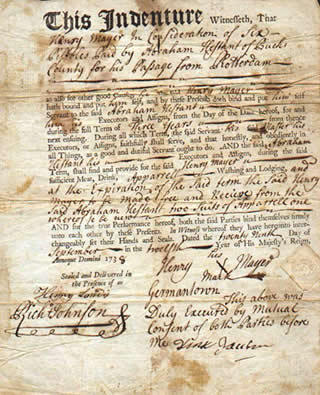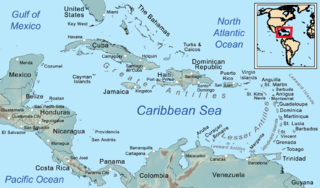
Barbados is an island country in the Lesser Antilles of the West Indies, in the Caribbean region next to North America and north of South America, and is the most easterly of the Caribbean islands. It lies on the boundary of the South American and Caribbean plates. Its capital and largest city is Bridgetown.
Barbados is an island country in the southeastern Caribbean Sea, situated about 100 miles (160 km) east of Saint Vincent and the Grenadines. Roughly triangular in shape, the island measures some 21 miles (34 km) from northwest to southeast and about 14 miles (23 km) from east to west at its widest point. The capital and largest town is Bridgetown, which is also the main seaport.

Indentured servitude is a form of labor in which a person is contracted to work without salary for a specific number of years. The contract called an "indenture", may be entered voluntarily for a prepaid lump sum, as payment for some good or service, purported eventual compensation, or debt repayment. An indenture may also be imposed involuntarily as a judicial punishment. The practice has been compared to the similar institution of slavery, although there are differences.

Coolie is a pejorative term used for low-wage labourers, typically those of Indian or Chinese descent.
Indo-Caribbean people or Indian-Caribbean people are people in the Caribbean who trace their ancestry to the Indian subcontinent. They are descendants of the Jahaji indentured laborers from British India, who were brought by the British, Dutch, and French during the colonial era from the mid-19th century to the early 20th century. A minority of them are descendants from people who immigrated as entrepreneurs, businesspeople, merchants, engineers, doctors, religious leaders, students, and other professional occupations beginning in the mid-20th century and continuing to the present.
Afro-Caribbean or African Caribbeanpeople are Caribbean people who trace their full or partial ancestry to Africa. The majority of the modern Afro-Caribbean people descend from the Africans taken as slaves to colonial Caribbean via the trans-Atlantic slave trade between the 15th and 19th centuries to work primarily on various sugar plantations and in domestic households. Other names for the ethnic group include Black Caribbean, Afro- or Black West Indian, or Afro- or Black Antillean. The term West Indian Creole has also been used to refer to Afro-Caribbean people, as well as other ethnic and racial groups in the region, though there remains debate about its use to refer to Afro-Caribbean people specifically. The term Afro-Caribbean was not coined by Caribbean people themselves but was first used by European Americans in the late 1960s.

Barbadians, more commonly known as Bajans, are people who are identified with the country of Barbados, by being citizens or their descendants in the Bajan diaspora. The connection may be residential, legal, historical or cultural. For most Bajans, several of those connections exist and are collectively the source of their identity. Bajans are a multi-ethnic and multicultural society of various ethnic, religious and national origins; therefore Bajans do not necessarily equate their ethnicity with their Bajan nationality.
The Indian indenture system was a system of indentured servitude, by which more than 1.6 million workers from British India were transported to labour in European colonies, as a substitute for slave labour, following the abolition of the trade in the early 19th century. The system expanded after the abolition of slavery in the British Empire in 1833, in the French colonies in 1848, and in the Dutch Empire in 1863. British Indian indentureship lasted till the 1920s. This resulted in the development of a large South Asian diaspora in the Caribbean, Natal, East Africa, Réunion, Mauritius, Sri Lanka, Malaysia, Myanmar, and Fiji, as well as the growth of Indo-Caribbean, Indo-African, Indo-Mauritian, Indo-Fijian, Indo-Sri Lankan, Indo-Malaysian, and Indo-Singaporean populations.
Colonel Sir Thomas Modyford, 1st Baronet was a planter of Barbados and Governor of Jamaica from 1664 to 1671.
White Barbadians or European Barbadians are Barbadian citizens or residents of European descent. The majority of European Barbadians are descended from English, Portuguese, and Scottish settlers and Irish indentured servants and settlers, who arrived during the British colonial period. Other European groups consisted of the French, Germans, Austrians, Spaniards, Italians, and Russians. In addition, some of those considered to be European Barbadians are of partial European ancestry and vice versa. The CIA World Factbook estimates that there are some 20,000 white Barbadians in the country.
BarbadianAmericans are Americans of full or partial Barbadian heritage. The 2000 Census recorded 53,785 US residents born on the Caribbean island 52,170 of whom were born to non-American parents and 54,509 people who described their ethnicity as Barbadian. The 2010 US Census estimation report stated more than 62,000 Barbadian Americans are resident in the United States, most of whom are in the area of New York City extending from Rhode Island to Delaware. In past years, some also moved to the areas of Chicago, Illinois, and Boston, Massachusetts.
Irish people in Jamaica or Irish Jamaicans, are Jamaican citizens whose ancestors originated from Ireland. If counted separately, Irish people would be the second-largest reported ethnic group in Jamaica, after Afro-Jamaicans.
Buckra or Backra is a term of West African origin. It is mainly used in the Caribbean and the Southeast United States. Originally, it was used by slaves to address their white owners. Later, the meaning was broadened to generally describe white people.
Irish transport to Barbados dates back to the 1620s, when Irish people began arriving on the island. The majority were emigrants, indentures, and merchants, though with an unknown number of political and convict transportees during the 1650s

Black Barbadians or Afro-Barbadians are Barbadians of entirely or predominantly African descent.
Migration from Ireland to Saint Kitts and Nevis in the West Indies began in the 1620s, when the islands of Saint Kitts and Nevis became part of the British Empire, and continued into the 18th century.
Irish Caribbean people are people who live in the Caribbean, but were born in Ireland, or are descended from people who were born in Ireland. Irish Caribbean people include:

Indentured servitude in British America was the prominent system of labor in the British American colonies until it was eventually supplanted by slavery. During its time, the system was so prominent that more than half of all immigrants to British colonies south of New England were white servants, and that nearly half of total white immigration to the Thirteen Colonies came under indenture. By the beginning of the American Revolutionary War in 1775, only 2 to 3 percent of the colonial labor force was composed of indentured servants.

Irish indentured servants were Irish people who became indentured servants in territories under the control of the British Empire, such as the British West Indies, British North America and later Australia.
Irish immigration to Montserrat dates back to the early 17th century before and during the period of plantation owners and slavery. Montserrat is a Caribbean island and overseas territory of the United Kingdom. It is also known as "The Emerald Isle of The Caribbean" due to the large population of people with Irish descent living there. Irish people first arrived to the island in 1632 and people of mixed race with Irish descent still live on the island.




